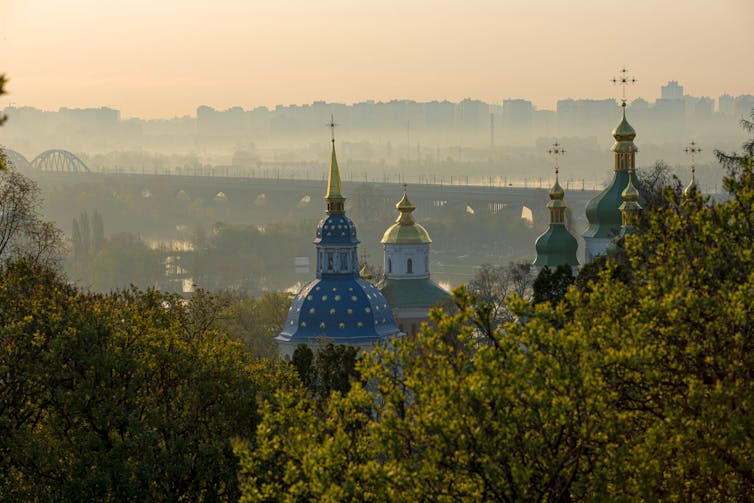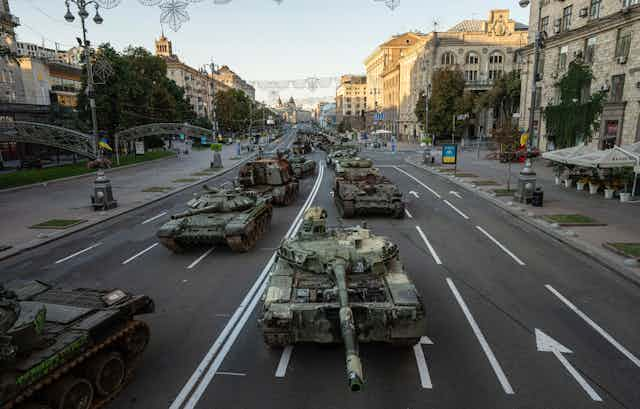On Aug. 24, 1991, I was one of a handful of foreign journalists working for a British newspaper and in the Ukrainian parliament when legislators surprised the world and voted for Ukraine’s declaration of independence.
This year Ukraine is once again surprising the world with its resilience in the face of Russia’s ongoing attack on its statehood. That’s possibly because prior to the February 2022 invasion, the world didn’t know much about Ukraine. Some continue to have impressions of the country that were shaped by imperial Russia, and replicated by some western scholars, portraying Ukraine as part of Russia or at least in Russia’s sphere of influence.
Susan Viets was The Independent’s reporter in Kyiv in 1991 and we became friends. She had an MA in Russian and East European Studies from one of Britain’s top universities, but upon arriving in Ukraine was surprised to learn that Ukrainians had a different vision of their history from what she’d been taught.
Russians were also surprised when Ukraine declared independence. For centuries they had been fed a story that Kyiv was the cradle of their civilization and that Ukrainian national aspirations were a foreign plot to weaken Russia.
Imperial expansion
This narrative was constructed after imperial Russia’s expansion into central Ukrainian lands in the 18th century. The invasion was intended to legitimize control over territory and construct a foundational myth based around the ancient Kyivan-Rus past, much older than Moscow.
Read more: How Moscow has long used the historic Kyivan Rus state to justify expansionism
Russian historians created what Canadian scholar Zenon Kohut described as the “unity paradigm” in which the Russian people are allegedly composed of three branches, the “Great Russians,” the “Little Russians” — how Russians describe Ukrainians — and “White Russians,” the name they use for Belarusians.
Later, in 1783 when the Russian Empire conquered Crimea from the Ottomans, the myth was expanded to include the peninsula as historic Russian lands.

When Ukraine voted for independence — a dramatic series of events brilliantly captured in a must-watch documentary series called Collapse: How Ukrainians Destroyed the Evil Empire — Moscow panicked.
Russian leader Boris Yeltsin said that borders with Ukraine needed revision and dispatched a special delegation to Kyiv to deal with the “emergency situation” on Aug. 28, 1991, four days after Ukraine’s parliament voted for independence.
Yury Shcherbak, a Ukrainian MP involved with the delegation, described a flight to Kyiv on which the delegation members were nervous, drinking and asking each other incredulously what had those “khokhly” done? Khokohl is a derogatory term Russians use for Ukrainians.
Things smoothed over in 1991, however. In the first post-Soviet decade, Russia-Ukraine relations remained peaceful, despite mounting tensions over Crimea, the Black Sea Fleet, nuclear weapons, borders and Ukraine’s moves to integrate with Europe.
Ukraine gradually sorted out its economy and became part of the international community, but internal divisions persisted. In 2004, things came to a head over a presidential election and erupted in what is known as the Orange Revolution, referred to by Russia as a “foreign plot.”
Ukraine ‘felt European’
I was in Ukraine on sabbatical at the time and Susan came to visit me. She couldn’t believe how much the country had changed from its Soviet decrepitude and noted it felt European.
Things had changed even more when corrupt, seemingly pro-Russian president Victor Yanukovych was poised to sign the Ukraine-European Union Association Agreement in 2013, then decided not to after a trip to Moscow. Another revolution erupted — the Euromaidan uprising, once more called a foreign plot by Russia. After it succeeded, Russia annexed Crimea and started a hybrid war in eastern Ukraine.
Russian President Vladimir Putin kept repeating the unity paradigm — “Russians and Ukrainians are one people — a single whole” — and then launched his full-scale military invasion in February 2022 to bring Ukraine back under Russia’s control.
He was probably surprised when Ukrainian President Volodymyr Zelenskyy reportedly refused an American offer to evacuate and said: “I need ammunition, not a ride.”
Many Ukrainians are standing up against Russian attempts to eradicate their state. The strength, determination and skill with which Ukrainians are asserting that they are not “little Russians” may eventually lead Putin to reconsider his perceptions about Ukraine.

Independence Day celebrations
This year, Susan and I planned to travel to Ukraine for Independence Day, but all public celebrations were cancelled for safety reasons and our friends advised us not to come. Russian forces marked the occasion by launching a deadly missile attack on a Ukrainian train station.
But Ukrainians once again found a creative way to celebrate.
Instead of the usual parade, they lined Kyiv’s main street with destroyed Russian military equipment.
So we toasted an independent Ukraine’s 31st birthday in Toronto, not at all surprised by the strength, courage and resilience of Ukrainians.

